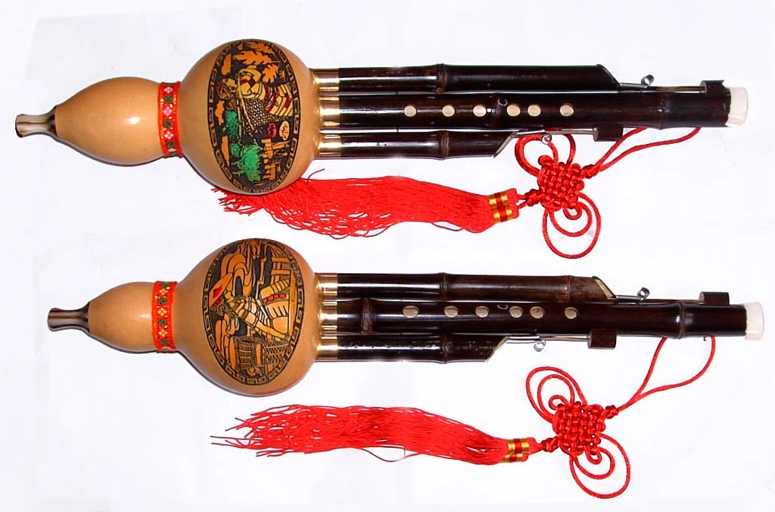The historical origin of cucurbit silk
1059 views · Organized by 不知桃夏 on 2022-02-23
Hulusi has a long history and was gradually evolved and transformed from the "sheng" in the Central Plains. Originated in the Central Plains, and later spread to the southwestern minority areas. The structure still maintains the legacy of ancient musical instruments. Its two auxiliary pipes do not open sound holes, like the ancient Xiao, and can be used to produce continuous fifths. However, its director has opened 7 sound holes, which is very similar to the later Xiao and Di, showing its radicality in history. However, today's gourd flute still maintains the characteristics of ancient similar instruments in structure.
The shape and structure of the cucurbit silk is unique, it is made of a complete gourd, plus three bamboo tubes and three metal reeds. At the handle end of the gourd, a bamboo pipe is inserted as a mouthpiece, and the gourd is used as a resonance box; three bamboo pipes with different thicknesses are inserted into the bottom of the gourd, each bamboo pipe is inlaid with a copper or silver reed, and the middle The main pipe is the thickest, with seven sound holes on it, which can blow out the melody, and the auxiliary pipes on both sides can only produce harmonics that resonate with the main pipe.
Gourd flute, gourd flute and flute every year during the slack season or during various festivals and gatherings, as well as during the usual labor, are a good time for Achang youth to talk about love and find lifelong partners. Whenever this time, no matter where the young men go, they will stick the March Xiao at the back of the neck in the collar, or pin it at the waist. No matter in the village, next to the village, or on the way to the street, as long as you meet a girl you love, you will play the music that you can listen to, and ask the girl to stop for a while, and then come up to chat and ask the girl's famous name. If the girl is still out of love at this time, and consciously knows each other, she will respond skillfully. The young man understood and offered to send the girl home, but the girl replied, "If you want to send it, you have to send it to Zhaizitou, and you can't send it halfway." So the young man happily played the flute, sang folk songs, and accompanied the girl home, pure and innocent. love begins here.
Whenever the sun goes down, the young men, after dinner, are busy washing and decorating, they quietly come to the house of their beloved girl, play the gourd flute, and use beautiful tunes to entice their sweethearts to come out to meet. The girl was flustered when she heard this kind and familiar tune, and hurried back to her room to dress up. Then go out for an excuse to have a tryst with a lover. If it is the first visit, the girl's sister-in-law or mother will open the door warmly and invite the young man to sit down by the fire in the house, and the family will avoid it. So the young man and the girl sat by the fire pit affectionately facing each other, or sang love songs duet, or whispered, lingering love words, and broke up reluctantly until the rooster announced the dawn.
Due to the differences between ethnic groups and regions, the gourd flute of other ethnic minorities in Yunnan Province is still different in shape and playing method. However, they all have a common feature, that is, they are often used to play folk songs, especially good at playing music with smooth melody. Generally, there are more long tones in the tune, the chorus is rich, and the music is soft and harmonious, which can better express the player. thoughts and feelings.
After the founding of the People's Republic of China, Chinese folk musicians carried out continuous reforms on the cucurbit silk. In 1958, the Yunnan Song and Dance Troupe first expanded the vocal range to 14 tones. Some literary and art groups in Beijing have made two new types of cucurbit silk. Among them, the six-hole cucurbit flute can play single tone, double tone, single melody plus continuous tone and two harmonic melody plus continuous tone. It not only maintains the unique timbre and style of the original instrument, but also increases the volume, expands the sound range, and enriches the sound color and expressiveness. The gourd flute, a folk musical instrument of Chinese ethnic minorities, was put on the stage, and it also appeared on the world art stage with the visits of Chinese musicians.
The shape and structure of the cucurbit silk is unique, it is made of a complete gourd, plus three bamboo tubes and three metal reeds. At the handle end of the gourd, a bamboo pipe is inserted as a mouthpiece, and the gourd is used as a resonance box; three bamboo pipes with different thicknesses are inserted into the bottom of the gourd, each bamboo pipe is inlaid with a copper or silver reed, and the middle The main pipe is the thickest, with seven sound holes on it, which can blow out the melody, and the auxiliary pipes on both sides can only produce harmonics that resonate with the main pipe.

Gourd flute, gourd flute and flute every year during the slack season or during various festivals and gatherings, as well as during the usual labor, are a good time for Achang youth to talk about love and find lifelong partners. Whenever this time, no matter where the young men go, they will stick the March Xiao at the back of the neck in the collar, or pin it at the waist. No matter in the village, next to the village, or on the way to the street, as long as you meet a girl you love, you will play the music that you can listen to, and ask the girl to stop for a while, and then come up to chat and ask the girl's famous name. If the girl is still out of love at this time, and consciously knows each other, she will respond skillfully. The young man understood and offered to send the girl home, but the girl replied, "If you want to send it, you have to send it to Zhaizitou, and you can't send it halfway." So the young man happily played the flute, sang folk songs, and accompanied the girl home, pure and innocent. love begins here.
Whenever the sun goes down, the young men, after dinner, are busy washing and decorating, they quietly come to the house of their beloved girl, play the gourd flute, and use beautiful tunes to entice their sweethearts to come out to meet. The girl was flustered when she heard this kind and familiar tune, and hurried back to her room to dress up. Then go out for an excuse to have a tryst with a lover. If it is the first visit, the girl's sister-in-law or mother will open the door warmly and invite the young man to sit down by the fire in the house, and the family will avoid it. So the young man and the girl sat by the fire pit affectionately facing each other, or sang love songs duet, or whispered, lingering love words, and broke up reluctantly until the rooster announced the dawn.

Due to the differences between ethnic groups and regions, the gourd flute of other ethnic minorities in Yunnan Province is still different in shape and playing method. However, they all have a common feature, that is, they are often used to play folk songs, especially good at playing music with smooth melody. Generally, there are more long tones in the tune, the chorus is rich, and the music is soft and harmonious, which can better express the player. thoughts and feelings.
After the founding of the People's Republic of China, Chinese folk musicians carried out continuous reforms on the cucurbit silk. In 1958, the Yunnan Song and Dance Troupe first expanded the vocal range to 14 tones. Some literary and art groups in Beijing have made two new types of cucurbit silk. Among them, the six-hole cucurbit flute can play single tone, double tone, single melody plus continuous tone and two harmonic melody plus continuous tone. It not only maintains the unique timbre and style of the original instrument, but also increases the volume, expands the sound range, and enriches the sound color and expressiveness. The gourd flute, a folk musical instrument of Chinese ethnic minorities, was put on the stage, and it also appeared on the world art stage with the visits of Chinese musicians.
Involving musical instruments
Hulusi (pinyin: hú lu sī), also known as "calabash flute", is a musical instrument of ethnic minorities in Yunnan. Hulusi originated in Lianghe County, Dehong Dai and Jingpo Autonomous Prefecture, and is mainly popular in Dai, Achang, Wa, De'ang and Brown. The Dehong and Lincang areas in Yunnan where ethnic groups live together are rich in local colors.
Guess you like
Organized by 南丘 on 2025-01-24
As a traditional Chinese wind instrument, hulusi is deeply loved by music lovers for its unique timbre and cultural connotation. However, because its material is mostly natural materials, such as bamboo, wood, etc., in the low temperature and dry environment, these materials are prone to shrinkage, cracking and other problems, which affects the sound quality and service life of fenugreek.
read >>
Organized by 氯化钠 on 2024-03-11
With the continuous integration of modern technology and traditional craft, fenugreek, an ancient national musical instrument, is also constantly innovating and developing, and a new type of multi-functional fenugreek has emerged. This new type of fenugreek not only retains the traditional graceful sound and strong national customs, but also adds a number of practical functions on the basis of the original, further improving the performance experience and teaching efficiency.
read >>
Organized by 风月呢喃 on 2024-03-11
Hulusi, as a traditional wind instrument of ethnic minorities in southwest China, has been deeply loved by music lovers for its beautiful, deep feeling and poetic tone. So, what exactly gives fenugreek such intoxicating sound?
read >>
Organized by 阿蘅 on 2024-03-11
Hulusi, as a typical representative of the traditional wind instrument of the ethnic minorities in southwest China, has a melodious tone and is deeply loved by the majority of music lovers. When discussing the charm of hulusi, its rich mode system is particularly worthy of attention. The variety of tone of hulusi enables it to perform a variety of different styles and emotional music.
read >>
Organized by 苏肆 on 2024-03-09
As a unique national wind instrument, double tone fenugreek is a product of innovative design based on the traditional single tone fenugreek. Its biggest feature is that it is equipped with one or more artificial blow holes and resonance cavity connected with the tube, so that the performer can issue two different sounds at the same time on the same instrument, which greatly enriches the expressive force and musical level of the gourd.
read >>
 渝公网安备 50010702504639号
渝公网安备 50010702504639号